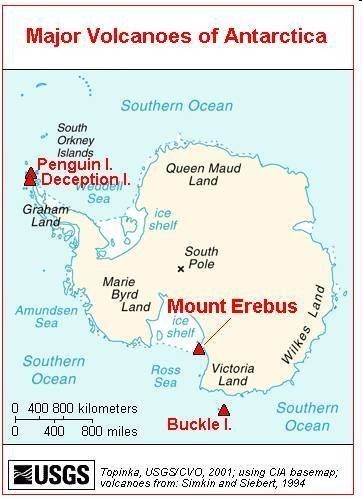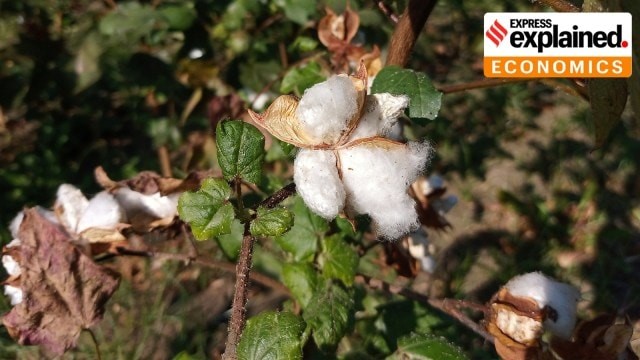Mount Erebus

- 10 Mar 2025
In News:
- Volcanic ice caves beneath Mount Erebus host thriving microbial life, offering insights into extremophile survival and potential life on alien planets.
About Mount Erebus:
- Location: Ross Island, Antarctica, in the Ross Sea.
- Type:Glaciated intraplate stratovolcano; part of the Pacific Ring of Fire.
- Altitude:3,794 meters (12,448 feet) above sea level.
- Rank:Second tallest volcano in Antarctica (after Mount Sidley).
- Discovered: In 1841 by British explorer Sir James Clark Ross.
- Name Origin: Named after Ross’s ship, HMS Erebus.
Volcanic Activity:
- Southernmost active volcano on Earth.
- Continuously active since 1972.
- Eruptions are Strombolian in nature — small, explosive, with lava bombs ejected onto crater rim.
- Contains a persistent lava lake with alkalic lava, typical of rift volcanoes.
Proximity to Human Activity:
- Near McMurdo Station, the largest Antarctic research base, just ~40 km away.
Scientific Significance:
- The microbial ecosystems in volcanic ice caves could help understand:
- Life in extreme environments
- Astrobiological prospects on Mars or Europa
Bollgard-3

- 10 Mar 2025
In News:
Punjab's cotton sector is facing a severe crisis due to increasing pest infestations and declining yields. In response, there is a rising demand for advanced genetically modified (GM) cotton varieties, particularly Bollgard-3, ahead of the 2025 sowing season.
Key Facts:
Decline in Cotton Cultivation in Punjab:
- Cotton acreage in Punjab has drastically declined from ~8 lakh hectares (1990s) to just 1 lakh hectares (2024).
- The ginning industry has also shrunk — only 22 ginning units remain functional, down from 422 in 2004.
- The main causes are whitefly (2015–16) and pink bollworm (2018–19) infestations.
About Bollgard Series of Bt Cotton:
Version Introduced in India Features
Bollgard-1 2002 Contains Cry1Ac gene — limited pest resistance
Bollgard-2 2006 Added Cry2Ab gene — wider pest control, still ineffective against
whiteflies and pink bollworms
Bollgard-3 Not approved in India Contains Cry1Ac, Cry2Ab, and Vip3A — effective against
lepidopteran pests like pink bollworm
- Bollgard-3, developed by Monsanto, offers enhanced pest resistance, but remains unapproved in India despite global usage.
- Bt (Bacillus thuringiensis) is a soil-dwelling bacterium used in GM crops for pest resistance by producing insecticidal proteins.
Alternative in Pipeline – BG-2RRF:
- Bollgard-2 Roundup Ready Flex (BG-2RRF) is aherbicide-tolerant GM cotton variety pending final regulatory approval in India.
- Enables better weed control and potentially reduces pest hosts, boosting yield.
- Field trials for BG-2RRF were conducted in 2012–13, but commercial approval remains pending.
- Experts argue that regulatory hurdles are delaying the adoption of next-generation GM seed technologies, affecting India's cotton competitiveness.
Current Agronomic Recommendations:
- In absence of new GM varieties, experts suggest:
- High-density planting
- Drip fertigation
- Proper seeding and mulching
- However, pest management remains a critical issue under current practices.
Comparative Global Context:
- Countries like Brazil are using Bollgard-5, achieving yields of 2400 kg/ha, compared to 450 kg/ha in India.
- India's profit margin from cotton is just 15%, whereas Brazil enjoys 85% margins due to advanced biotech adoption.
Rare Civet Cat
- 10 Mar 2025
In News:
Recently, a rare civet cat, typically native to the Seshachalam forests near Tirumala, was unexpectedly sighted near Tadepalli in Guntur district, Andhra Pradesh. The animal entered a residential area, startling locals, and was later safely rescued and examined by forest officials.
About Civet Cats
- Taxonomy:Civets belong to the Viverridae family, which includes civets, genets, oyans, and linsangs. There are 15–20 species across 10–12 genera.
- Distribution:Found in Africa, southern Europe, and Asia, including eight wild species in India.
- Common Palm Civet and Small Indian Civet are widely distributed.
- The Malabar Large-spotted Civet (Viverracivettina) is critically endangered and endemic to the Western Ghats.
- Conservation Status:The Malabar Civet is listed as Critically Endangered under the IUCN Red List.
Physical Characteristics:
- Appearance: Cat-like, with thickly furred tail, pointed snout, and small ears.
- Size: Body length: 40–85 cm; Tail: 13–66 cm; Weight: 1.5–11 kg.
- Coloration: Usually buff or grayish, with black spots, stripes, or both.
Behavior and Habitat:
- Nocturnal and Solitary: Typically dwell in tree hollows, rocks, or similar secluded areas.
- Diet: Primarily frugivorous and insectivorous, occasionally feeding on small animals.
- Habitat Range: Though mostly forest-dwelling, rare sightings in urban zones have occurred, as seen in the Tadepalli incident.
Significance of Recent Sighting:
- The civet descended from Tadepalli hills and entered a home, prompting forest department intervention.
- Identified as a rare species similar to African civets.
- Medically examined, found healthy, and is to be rehabilitated into the wild.
- The incident highlights growing human-wildlife interactions and the need for urban wildlife awareness.
Dragon Copilot

- 10 Mar 2025
In News:
Microsoft has launched Dragon Copilot, a voice-activated AI assistant designed specifically for the healthcare sector. It aims to reduce administrative burdens on clinicians by automating documentation and providing quick access to medical information.
Key Features and Functionalities:
- Platform Integration: Part of Microsoft Cloud for Healthcare, Dragon Copilot integrates with Electronic Health Records (EHR) and is accessible via desktop, browser, or mobile app.
- Technology Base: Built on Nuance’s Dragon Medical One (DMO) and DAX (Dragon Ambient eXperience) platforms, which have supported transcription of billions of patient records and over 3 million ambient patient interactions.
- Voice & AI Capabilities:
- Uses natural language dictation and ambient listening technologies.
- Enhanced with generative AI and healthcare-specific safeguards.
- Allows drafting of memos, referral letters, clinical summaries, and after-visit notes in personalized formats.
- Facilitates real-time voice-to-text transcription and AI-generated notes via user prompts or templates.
- Supports automated search for verified medical information.
Benefits:
- Reduces clinician paperwork and burnout, enhancing focus on patient care.
- Survey Data (Microsoft Findings):
- Saves ~5 minutes per patient interaction.
- 70% clinicians reported reduced fatigue.
- 62% were less likely to leave their organizations.
- 93% patients reported improved experiences.
Concerns and Risks of Healthcare AI:
- AI Hallucinations: Tools like OpenAI’s Whisper have produced fictitious content, including inappropriate or incorrect medical information.
- Regulatory Caution:
- The US FDA warns of risks from generative AI in healthcare, including false diagnoses or biased outputs.
- Emphasizes the need for transparent and accountable development practices.
- Microsoft’s Response:
- Claims to have integrated “clinical, chat, and compliance safeguards” into Dragon Copilot.
- Built in alignment with Microsoft’s Responsible AI principles, although technical specifics remain undisclosed.
Broader AI Healthcare Landscape:
- Companies like Google Cloud, Abridge, and Suki are developing similar AI-based healthcare assistants.
- Growing interest in generative AI for reducing clinician workload and improving patient outcomes is driving innovation and investment across the sector.
Doubtful (D) Voters in Assam
- 10 Mar 2025
In News:
The issue of ‘D’ (Doubtful) voters recently resurfaced in the Assam Legislative Assembly, with the Opposition demanding closure of the state’s lone detention centre (now termed a transit camp) and the tabling of the National Register of Citizens (NRC) report.
Who are ‘D’ Voters?
‘D’ voters are individuals whose Indian citizenship is under suspicion. Introduced by the Election Commission of India (ECI) in 1997 specifically for Assam, these individuals are barred from voting or contesting elections until their citizenship is verified.
Legal and Procedural Aspects:
- Not Defined in Law: The term 'Doubtful Voter' is not defined under the Citizenship Act, 1955 or the Citizenship Rules, 2003.
- As per Citizenship Rules, 2003:
- The Local Registrar must mark individuals with doubtful citizenship in the National Population Register (NPR) for further verification.
- Affected individuals must be informed through a prescribed format and granted a hearing before the Taluk or Sub-district Registrar.
- A decision on citizenship status must be made within 90 days.
- Foreigners Tribunal (FT): Cases of D-voters are referred to FTs, which decide whether the person is an Indian citizen or a foreigner. Based on the verdict, individuals can be:
- Cleared and subsequently included in the NRC and electoral rolls.
- Declared foreigners, leading to deportation or detention.
Key Features of D-Voter Status:
- Temporary Tag: The 'D' classification is not permanent and must be resolved within a set timeframe.
- Appeal Mechanism: Individuals can appeal to the Foreigners Tribunal for clearance.
- Impact on Families: Often, some members of a family are citizens while others are tagged as D-voters, leading to legal and social complications.
- Detention Concerns: Several individuals, including potential Indian citizens, have been detained for years without a clear mechanism for release.
Recent Developments:
- Political demands in Assam include the closure of detention centres and transparency regarding NRC implementation.
- Debates continue over the legal ambiguity and humanitarian implications of the D-voter category.
